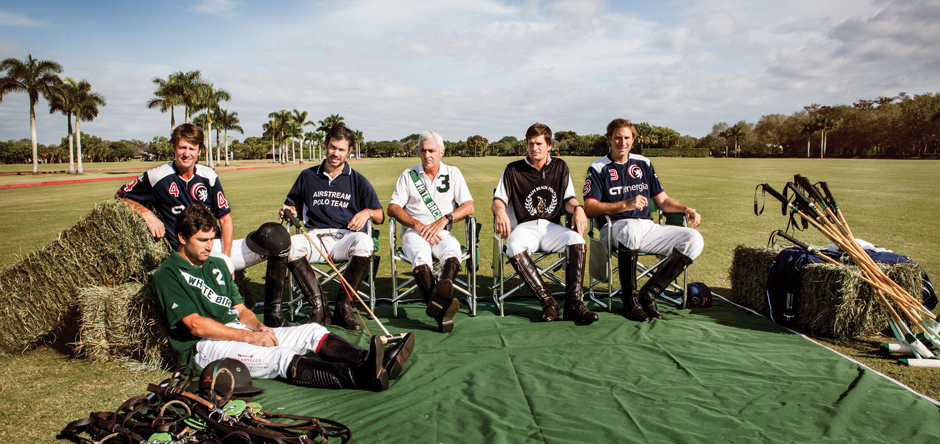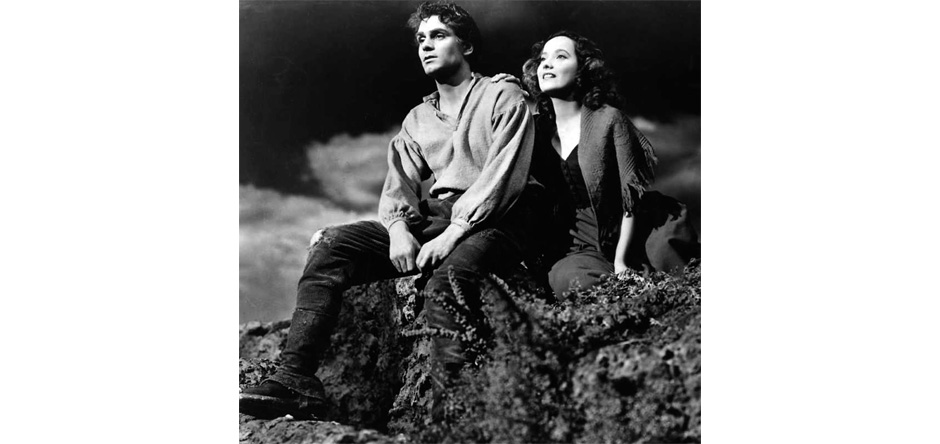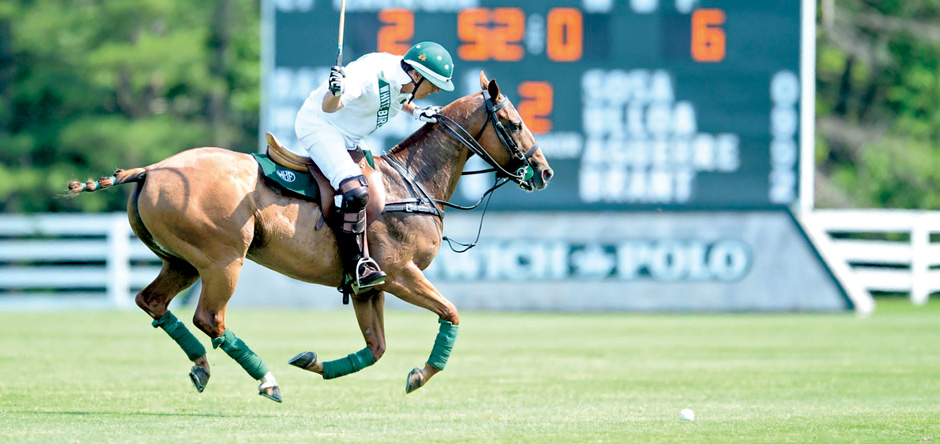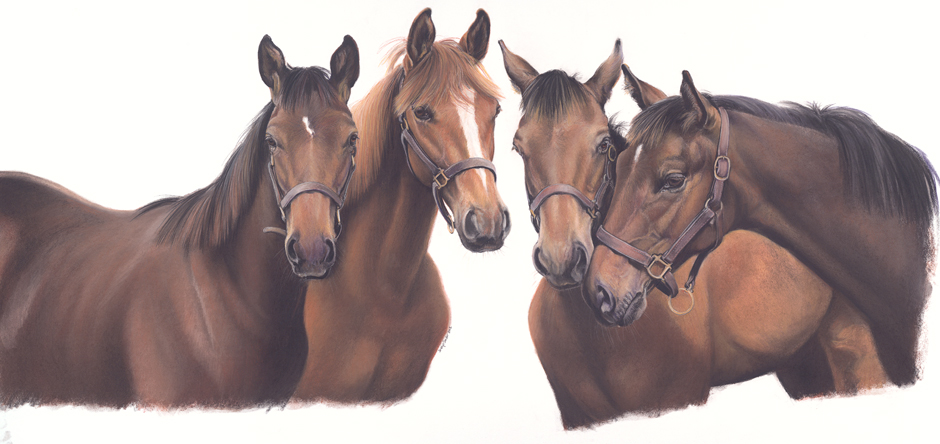All photographs by Juan Lamarca. Courtesy of Greenwich Polo Club.
Like many of the world’s finest polo players, Mariano Aguerre is from Argentina. But when he returns to the Greenwich Polo Club, which opens its season June 7, he’ll be coming home.
“I was born at Greenwich Polo,” says Aguerre, who won the U.S. Polo Association Gold Cup with the club’s White Birch team in 1987. “I started as a pro there … so I feel a special chemistry there. I feel comfortable there. It’s my favorite place.”
For the men of Greenwich Polo — who play either on or against the White Birch team established by club founder Peter Brant — the club is like no other place in the world.
“Well, it’s so beautiful, and it’s centrally located near New York City,” says Nick Manifold, who not only plays on the club’s verdant backcountry expanse (a space nine times the size of an American football field) but helps with its operation.
Adds Aguerre — who has won just about every polo title you might name multiple times, from the Argentine Open to the U.S. Open — “Everything has been developed in good taste, the stone clubhouse, the tents with their wood and shingles, by people who know what they’re doing.”
Indeed, there are probably not many sporting greens that are punctuated by such sculptures as Urs Fischer’s “Big Clay,” a kind of Postmodern “Winged Victory” that stands like a sentinel in one corner off the field. Brant is as ardent an art collector as he is a polo player.
Fans and newcomers alike will get a broader view of the facility when NBCSN telecasts the finals of the East Coast Open, which Greenwich Polo is presenting with the U.S. Polo Association Aug. 23 through Sept. 6. (The finals will actually be shown on Sept. 13.) This is not the first time a Greenwich Polo Club match has been televised, Manifold says, referring to the CBS telecast of the 1986 Americas Polo Championship, in which an Argentine team squared off against a North American one.
“It’s very exciting and great for the club facilities,” he says.
It will also offer the TV audience a rare glimpse into a thrilling, fluid, oft-misunderstood sport as well as the men (and increasingly, women) who play it.
Hockey on horseback
For the uninitiated, polo is played by two teams of four on horseback using mallets to strike a wooden or plastic ball through goalposts. The match is divided into six periods, or chukkers, with the team scoring the most goals winning. Each player has a handicap from 1 to 10, with 10 goals being the best.
At the Greenwich club, teams play high-goal polo, in which the team handicap is 20 or better. Aguerre, a 9-goaler, plays the No. 3 position, a kind of field commander.
“You have to adapt the way you play to the team you’re playing with and organize them. As the No. 3, you manage the speed of the horses.”
Argentina’s Ezequiel Martinez Ferrario, a 7-goaler whom you’ll see at Greenwich Polo this season with Team Palm Beach, plays the No. 2 position.
“No. 2 works to open the way for the No. 3,” he says through interpreter Mariana Castro, Greenwich Polo’s marketing director. “He really opens the field.”
Manifold, an Australian, is another No. 2 player, a position he assumes for Team CT Energia.
The No. 1 position is another offensive spot, while the No. 4 player is on defense.
“I play all kinds of sports,” Aguerre says, “tennis, golf, soccer. I find polo to be the perfect balance between the gentleman and the aggressor.”
Part of what makes polo particularly exciting to watch is the dynamic choreography that naturally unfolds among players and horses. At times the match is so intimately contested that the two- and four-legged players are flank to hip, the mallets seeming to tangle like Pick-up Sticks. Then someone, getting his mallet on the ball, breaks through, and the players come thundering down the field.
“The feeling you get when you’re on a breakaway, it’s a feeling you get no other place,” says Aguerre, who grew up on a farm, following in the footsteps of his polo-playing father and two older brothers. “It’s a unique sensation.”
The adrenaline that flows then is what Ferrario, who learned the sport from an uncle, says he loves about polo. That and the horses.
They’re called polo ponies, but they’re mature Thoroughbreds, usually mares and geldings, sometimes former racehorses that are retrained for polo. While a patrón, or team owner, might provide his players with horses, generally a player trains and trains with his own, using six to eight horses per match. Manifold, who started playing polo as a teenager Down Under, and Aguerre breed prize-winning polo ponies on Argentina’s Los Machitos Farm.
Manifold says, “You’re looking for a nice temperament, not too hot, good confirmation, agility, not too heavy of bone.” Adds Aguerre, “The horses have to be strong mentally.”
Maturity, mental strength, agility, good bones, an even temperament — sounds like the ingredients for an ideal polo player as well.
“You don’t want to be too big or muscular,” says Ferrario, who weighs 172 pounds at 5 feet, 9 inches and works with a personal trainer doing many repetitions of light weights.
But Manifold counters that a certain heft can come in handy when you’re striking the ball. It’s how you use that heft.
Still, “You don’t want to be a linebacker,” says Aguerre, who travels with trainer Norberto Imas. “I don’t go anywhere without him. He helps me mentally and physically. Hey, I’m 45. If I want to compete with young guys (like Ferrario, 31), I have to work out.”
‘The ball is the earth, and I am the stick’
Often called “the sport of kings,” polo — from the Tibetan “pulu,” meaning “ball” — had its origins in ancient Asia, specifically the Persia of emperors and their cavalry.
According to the Museum of Polo and Hall of Fame’s website, the Persian Emperor Darius III sent his Greco-Macedonian adversary Alexander the Great an early version of a mallet and ball as a way of demeaning the youthful, would-be conqueror — much as centuries later the French would send the seemingly callow Henry V of England a basket of tennis balls.
“The ball is the earth, and I am the stick,” Alexander is said to have replied.
He made good on that threat, sweeping across the Persian Empire aboard his fiery black steed Bucephalus to become lord of Asia, while polo would continue to be associated with military training. Indeed, the American Army would use polo as a regimen until World War II — the 1930s being the sport’s glory days in this country when it would draw crowds of 35,000.
After that, polo began to be considered more elitist, an image reinforced by the cost of maintaining polo ponies and by movies like “The Wolf of Wall Street,” “Pretty Woman” and Baz Luhrmann’s “The Great Gatsby” and the ABC series “Revenge.” It’s an image that’s changing.
Such programs as Work to Ride at the Chamounix Equestrian Center not far from Philadelphia’s Main Line seek to introduce disadvantaged children to polo and other equestrian sports. The Sentebale Royal Salute Polo Cup, contested at Greenwich Polo in 2013 with Prince Harry and polo player (and Polo spokesmodel) Nacho Figueras, raised money for the prince’s Sentebale charity, aiding youngsters at risk in Lesotho. A 2014 Greenwich Polo match was the site for a luncheon benefitting ECAD (Educating Canines Assisting With Disabilities), which provides our wounded warriors with service dogs.
These servicemen were among those who’ve enjoyed matches with relatives, friends and pet dogs — picnicking, taking in vendors and savoring the halftime tradition of stomping the divots, tufts of grass kicked up by the horses.
“It’s just a great family day,” Manifold says of any Greenwich Polo match.
Just as polo brings together humans and animals, professional players and talented amateurs like Peter Brant, the haves and have-lesses, polo is also, like other equestrian sports, one in which women can compete with and against men.
That’s because, Ferrario says, “a lot of the sport is about the horses.”
Women are the fastest growing segment of the game. Prominent players include Sunny Hale, the first woman to win the U.S. Open Polo Championship, and Dawn Jones, wife of actor Tommy Lee Jones, who was named MVP of the 2013 Sentebale Royal Salute Polo Cup.
While men may bring more power to swinging a mallet, the men of Greenwich Polo say they welcome women to the sport — many of whom are fine equestrians who began their careers in show jumping.
Whoever their teammates or opponents, the men of Greenwich Polo continue to dream big on and off its field.
Ferrario’s goal is to play in the Argentine Open of Polo in Palermo.
For Aguerre — who’s won that Open nine times, the U.S. Polo Association Gold Cup eight times, the C.V. Whitney Cup six times, the Hurlingham Open five times and the U.S. Polo Open Championship twice, among many titles — it’s all about an enduring passion.
“Polo is not what I do. It’s who I am,” he says. “It’s where I met my wife, my friends….You know, when I started, I didn’t think I’d be able to do 10 percent of what I’ve done. I’m playing with the casino’s money now. The love I have for the sport, the desire, is still there.”
The Greenwich Polo Club season opens June 7, with the Monty Waterbury Cup, which continues June 14 and 21. Then it’s the Butler Handicap June 28 and July 5 and 12. The East Coast Open will be contested Aug. 23 and Aug. 30, with the finals Sept. 6. (The finasl will actually be televised on NBCSN on Sept. 13.) The season closes Sept. 13. Gates open at 1 p.m. Sundays, with the matches at 3 p.m. The entry fee is $40 per car. The dress code is casual chic. (Ladies, remember your hats.) The field address is 1 Hurlingham Drive. For more, visit greenwichpolo.com.






http://greenwichpoloclub.com/
Is the correct Web address for Greenwich Polo Club schedule and events.